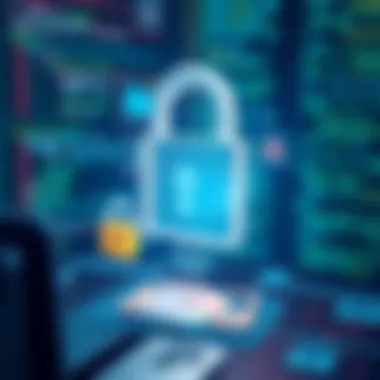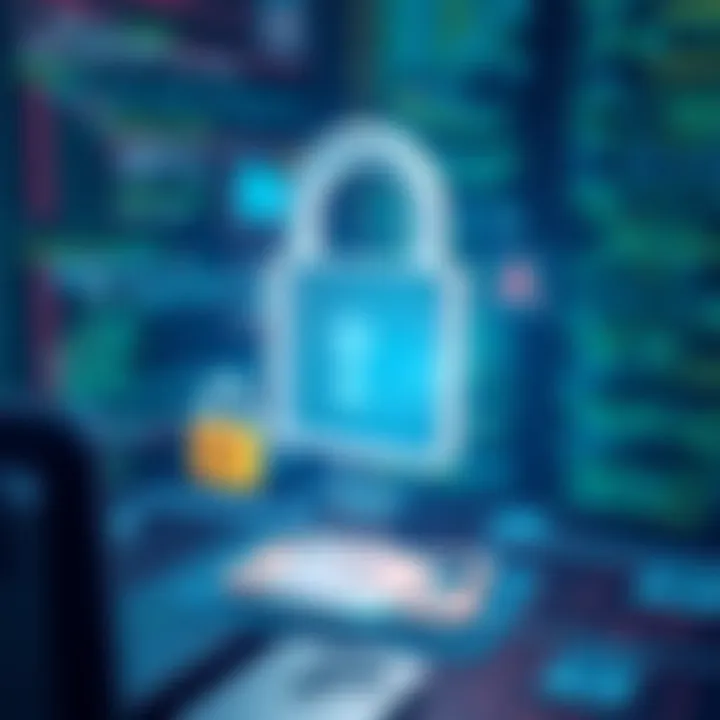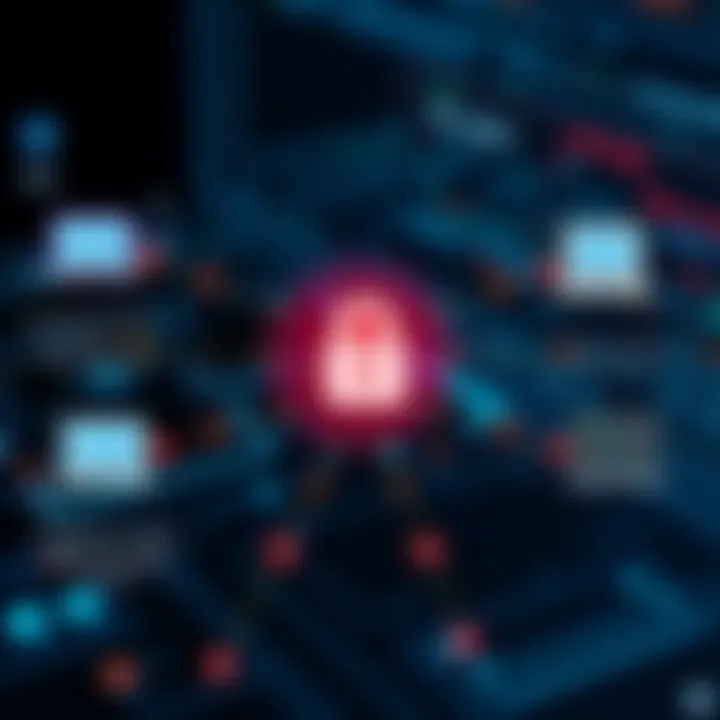Exploring Multi-Factor Authentication Solutions for Security


Intro
In today's digital landscape, the growing reliance on technology means that cybersecurity has never been more paramount. As businesses and individuals increasingly manage sensitive information online, the necessity for robust authentication methods rises in tandem. One such method, multi-factor authentication (MFA), has emerged as a fundamental element of cybersecurity protocols. This guide seeks to demystify MFA software, spotlighting its importance, the range of options available, and its broader implications within various sectors.
With increasing instances of data breaches and unauthorized access, understanding MFA software is not just beneficial; it's essential. By the end of this exploration, readers will be equipped with the knowledge to grasp how MFA can enhance their security measures and why integrating such solutions is critical to safeguarding digital assets.
Software Overview
Software Description
Multi-factor authentication software provides an additional layer of security by requiring users to verify their identity by providing multiple forms of evidence. Rather than just relying on a password, which can be easily intercepted or forgotten, MFA typically combines something the user knows (like a password), something the user has (such as an SMS code or hardware token), and possibly something the user is (biometric verification).
This layered approach adds complexity to unauthorized access attempts, thereby fortifying the security of sensitive data across various platforms. Whether it’s a banking application or enterprise resource planning system, MFA can be tailored to meet specific industry demands.
Key Features
With a myriad of MFA solutions on the market, it is necessary to discern the standout features that define effective software:
- Diverse Authentication Methods: Effective MFA solutions offer multiple authentication options including biometric scans, one-time passwords sent via text, and push notifications. This flexibility allows users to select methods that suit their needs.
- User Management: The software should provide seamless user management features, enabling administrators to add or revoke access quickly.
- Scalability: As organizations grow, so should their security solutions. MFA software needs to adapt and scale efficiently alongside the user base.
- Integration Capabilities: An ideal MFA solution can integrate with existing systems and applications. Compatibility with tools like Microsoft Active Directory or Google Workspace is vital.
- Reporting and Analytics: Tracking login attempts and analyzing authentication failures can provide crucial insights into potential security threats.
"Cybersecurity is not a destination, but a journey. Multi-factor authentication is an essential stop along that path to security."
User Experience
User Interface and Design
A sleek and intuitive user interface is crucial for MFA software. It should provide a seamless experience that doesn’t become an obstacle for users. Clear instructions, visually appealing design, and easy navigation are essential. Users should feel empowered rather than frustrated when interacting with the authentication process.
Many organizations have been challenged by adopting MFA due to the fear of its complexity. However, proper UI design can drastically simplify the process, leading to greater acceptance among users and decreasing the probability of password fatigue.
Performance and Reliability
No one enjoys a slow application or a malfunctioning service, especially when sensitive data hangs in the balance. Therefore, MFA solutions must demonstrate performance and reliability to foster trust. A solution that experiences frequent downtimes or lags in processing requests can be counterproductive, leading users to seek simpler, yet less secure pathways for access.
In summation, MFA software is an indispensable asset in the realm of cybersecurity. By enhancing understanding of its functionalities and importance, organizations can make informed decisions that align with their security goals and operational requirements. This exploration aims to not just present MFA as a software solution, but as a critical component of modern digital security strategies.
As we proceed, we will delve deeper into specific MFA solutions, implementation strategies, and emerging trends that will shape the future of digital authentication.
Understanding Multi-Factor Authentication
In today’s digitally driven landscape, understanding multi-factor authentication (MFA) is not just for tech enthusiasts. It’s a necessity for everyone who values security, especially businesses dealing with sensitive data. The reliance on usernames and passwords alone has become archaic in a world where cyber threats loom larger than ever. It’s essential to dissect the nuances of MFA to appreciate its role in fortifying your digital security framework.
Definition of Multi-Factor Authentication
At its core, multi-factor authentication is a security mechanism that requires multiple forms of verification before granting access to a system or application. Rather than relying only on a password, MFA demands additional proof. This might come from something you know, like a PIN, something you have, such as a smartphone app, or something you are, like a fingerprint. The layering of these authentication methods drastically reduces the chances of unauthorized access.
The concept can be boiled down to this: MFA enhances your defenses. The basic idea is to create hurdles for potential intruders so that even if one layer is compromised, the others remain intact. Consider an onion—each layer you peel back gets you closer to the core, but it takes time and effort to get through.
The Importance of MFA in Cybersecurity
Multi-factor authentication plays a pivotal role in today's cybersecurity strategies. As breaches surge, its importance grows exponentially. Here are some key considerations:
- Increased Security: By imposing additional verification factors, organizations can add an extra layer of safety. It’s like locking your doors and installing a security system; it only makes sense to go the extra mile in protecting your assets.
- Reduction in Fraud: With MFA, the chances of falling victim to phishing attacks diminish. If a hacker gets hold of your password but doesn’t have your authentication app, they're left in the lurch.
- Regulatory Compliance: Industries facing strict compliance requirements, such as healthcare and finance, often mandate MFA use. It’s a line in the sand that organizations must toe to avoid hefty penalties.
In a world where passwords are no longer sufficent, MFA stands as a bulwark against growing cyber threats.
In summation, understanding multi-factor authentication is a cornerstone of robust cybersecurity. As threats evolve, so must our strategies in defending against them. It’s indispensable for any organization looking to maintain the integrity of its data and protect its clients’ information.
Investing time to comprehend MFA isn’t just prudent; it’s essential in navigating the dynamic landscape of cybersecurity.
Types of Multi-Factor Authentication Software
In the world of cyber security, multi-factor authentication (MFA) plays a vital role in protecting sensitive data from unwarranted access. As threats continue to evolve, so do the means through which we secure our information. Understanding the types of MFA software available is crucial for businesses and individuals alike. Each type of software brings its own set of benefits, considerations, and challenges that must be weighed when selecting an appropriate solution for secure authentication.
SMS and Email Verification
One of the most straightforward types of multi-factor authentication uses SMS or email verification. When a user attempts to log in, a verification code is sent via text message or email. This method is simple and familiar for most users. The ease of use makes it attractive for applications with a broad user base, particularly in casual settings where users might not want complex setups.


However, it isn't without drawbacks. Relying on SMS can be problematic due to vulnerabilities in the mobile network, which can potentially allow hackers to intercept messages. Additionally, if users change their phone numbers or email addresses, it could hinder access. Nevertheless, for basic security needs, SMS and email verification can often serve as a first line of defense.
Authenticator Apps
Authenticator apps like Google Authenticator or Authy provide a more secure method for MFA. These applications generate time-sensitive codes that are accessible only on the user’s device, reducing the risk of interception inherent in SMS. With an authenticator app, a user typically needs to enter their username and password first, followed by a unique code generated on their device.
The advantage here is twofold: it eliminates the reliance on cellular service and is less likely to be subject to phishing attacks. The user experience is generally seamless once setup is completed. However, there are still usability challenges. If a user loses their phone or forgets the app’s backup codes, regaining access can become complicated and frustrating.
Hardware Tokens
For those seeking a more robust security solution, hardware tokens can be an excellent choice. These physical devices generate a code at regular intervals, which users must enter to complete the login process. They are often viewed as a gold standard for MFA because they are immune to many forms of cyber attacks.
While hardware tokens provide a high level of protection, they do come with logistical challenges. Users must carry the token on their person, and there’s always the risk of loss. Additionally, companies will need to budget for purchasing and managing these devices, which can become expensive, particularly in larger organizations.
Biometric Authentication
Biometric authentication represents one of the newest forms of multi-factor authentication, relying on unique biological traits such as fingerprints, face recognition, or even iris scans. This approach combines both something the user is and something they have, resulting in extremely robust security.
The main advantage is convenience; it's not only secure but also very user-friendly, as it removes the need for password management. However, there are serious privacy concerns associated with storing biometric data. If hacked, the implications of losing such sensitive personal information are substantial. Additionally, false negatives can occur, where a legitimate user is denied access due to inaccurate readings.
How Multi-Factor Authentication Works
Understanding the mechanics behind how multi-factor authentication (MFA) works is essential. It is not just a security add-on but a critical component of modern cybersecurity strategies. MFA enhances security by requiring a combination of two or more verification factors from users to gain access to a system or application. This process makes unauthorized access considerably tougher, significantly upping the ante for potential cybercriminals.
Authentication Processes Explained
In the simplest terms, the authentication process involves verifying a user’s identity through multiple layers. When a user attempts to access a system, it begins with the first layer, typically the entry of passwords. However, reliance on a single password is risky. Following the password entry, a second factor must be confirmed, which may include a code sent to the user's mobile device or a biometric scan.
Employing such layered security can mitigate risks associated with compromised passwords. Imagine a scenario where even if an attacker steals a user’s password, they would still need the second factor, making it far less likely that they can successfully breach the account. Modern systems often utilize a user-friendly approach that reduces friction by offering seamless transitions between different factors.
Factors Involved in MFA
When it comes to multi-factor authentication, each factor offers a unique layer of security, categorized into three main types:
Something You Know
This factor refers to knowledge-based credentials, like passwords or PINs. Its primary strength lies in its familiarity. Most users are accustomed to typing in a password, making it an intuitive first step. A key characteristic of this method is its accessibility; everyone is likely to remember at least a few passwords.
However, the downside is that passwords can be stolen, guessed, or forgotten. The uniqueness of something you know adds a familiar yet risky aspect to MFA since it relies heavily on the user's memory and behavior. The persistent problem of weak or reused passwords violates the security that this method aims to provide. Studies, like one from 2019, show that a staggering number of people still use easily guessable passwords, underscoring the need for robust backup factors.
Something You Have
This factor often involves physical devices or software tokens that a user possesses. This could range from an app that generates time-sensitive codes, like Google Authenticator, to hardware tokens such as YubiKeys. The unique feature of this method is its reliance on possession, meaning an attacker would need access to the physical object to breach security.
The main advantage here is that even if a password is compromised, the account remains secure without the physical item in hand. Nevertheless, there's a potential downside; if a user loses their device, recovering access can be a cumbersome process, potentially leading to locked-out accounts and frustration.
Something You Are
This factor revolves around biometric data. Fingerprint scans, facial recognition, and voiceprints fall into this category. The technology inherent in something you are is becoming increasingly sophisticated, often integrating directly into smartphones and laptops, making it widely accessible.
The critical benefit is its unique nature. Biometric traits are incredibly difficult to replicate or steal, adding an extra layer that is virtually personalized. However, the disadvantages cannot be ignored; issues with reliability or accessibility may arise, particularly in scenarios where users experience physical changes, like injury or aging, potentially causing inconvenience for legitimate users.
"The strength of multi-factor authentication lies in its ability to combine these factors, creating a fortress against unauthorized access rather than relying on a single point of failure."
Understanding how these factors work together to create a stronger security posture is crucial for IT professionals and businesses looking to protect sensitive data. Each method brings its own strengths and weaknesses, and the selection will often depend on the specific context of use and organizational requirements.
In summary, multi-factor authentication requires multiple verification methods to significantly enhance data security compared to traditional one-factor systems. As cyber threats continue to evolve, adapting robust methodologies will only become more critical for both individuals and businesses.
Selecting the Right MFA Solution
Selecting the right multi-factor authentication (MFA) solution is crucial in a world where cyber threats are becoming increasingly sophisticated. With myriad options available, choosing an appropriate system can feel overwhelming. However, the right choice can significantly enhance security while ensuring user convenience. Balancing these needs is key to a robust authentication strategy.
Key Features to Consider
When evaluating different MFA solutions, several core features must guide your decision. Here are some that stand out:
- User-Friendliness: The ease of use is paramount. Solutions that are confusing or cumbersome can lead to user resistance, negating their effectiveness.
- Scalability: As businesses grow, so too should their security measures. Opting for a scalable MFA solution allows organizations to adjust without drastic overhauls.
- Support for Multiple Methods: Different users may prefer different types of authentication. The best solutions support a combination—be it SMS, biometrics, or authenticator apps—catering to diverse preferences.
- Compliance Features: Many industries are subject to regulations that require strong authentication measures. Ensuring the solution meets these compliance standards is essential for audit trails and legal protections.
"For companies battling cyber threats, the right MFA solution can mean the difference between a minor issue and a major security breach."


Cost-Benefit Analysis of MFA Solutions
When analyzing costs, it’s imperative to go beyond mere initial investment. While some MFA solutions might present a higher upfront cost, their long-term benefits often provide a greater return on investment. Evaluate:
- Potential Losses from a Breach: A single data breach can cost companies millions in lost revenue and reputational damage. Investing in a solid MFA solution can mitigate these risks significantly.
- Training and Onboarding Expenses: Factor in the time and resources needed to train users on new systems. Some solutions are fairly straightforward, leading to lower training costs.
- Maintenance and Support Fees: Keep an eye on ongoing maintenance fees. A solution that requires a lot of upkeep may not be as economical in the long run.
- User Productivity: Solutions that promote a smoother user experience can boost productivity. If an MFA system causes delays, it can counteract any financial benefits.
Integration with Existing Systems
Another critical consideration is how well the chosen MFA solution meshes with current systems and practices. Here are a few factors to keep in mind:
- Compatibility with Legacy Systems: Many businesses still rely on older systems. Ensure the MFA solution is capable of integrating without requiring a complete overhaul of existing infrastructure.
- APIs and SDKs: Solutions that come with robust application programming interfaces (APIs) allow for greater flexibility, making it easier to integrate with various applications and platforms.
- User Authentication Protocols: If there are existing protocols for user authentication, ensuring the MFA solution aligns with them avoids confusion and streamlines processes.
Selecting the right MFA solution can seem like a mountain to climb. However, by considering these features and analyzing the costs and compatibility factors, organizations can effectively choose an MFA approach that bolsters their security posture while also respecting users’ experiences.
MFA Implementation Strategies
Implementing Multi-Factor Authentication (MFA) is not just about putting up barriers; it’s about creating a layered approach to security that enhances safety without alienating users. The importance of crafting a robust MFA implementation strategy cannot be overstated, particularly as businesses grapple with increasing cyber threats. This section outlines essential elements that ensure successful deployment, both from a technical standpoint and with a keen focus on user experience.
Planning and Preparation Steps
Before diving head first into MFA deployment, it’s crucial to lay the groundwork. Planning acts as the bedrock for sustainable implementation. Take these preparatory steps into account:
- Assessment of Current Systems: Understand the existing authentication methods in place. Identify vulnerabilities. Are there access points that need immediate protection?
- Define Requirements and Objectives: Establish clear goals. Are you aiming to protect sensitive financial data, or is the focus on securing personal information of clients? Setting objectives helps direct the choice of MFA methods.
- Engage Stakeholders: Involve essential team members from IT, security, and user experience departments. Their insights can shape an MFA strategy that understands technical barriers and user preferences.
Once you’ve laid the groundwork, it’s time to choose appropriate MFA methods that foster security without being cumbersome.
User Training and Onboarding
Adoption of any new technology requires a strong training program. This is particularly true for MFA, where understanding the rationale behind security measures can dramatically improve compliance rates. Consider these points during the onboarding process:
- Create Clear Communication: Transparency is key. Inform users about why MFA is being implemented and how it protects their information.
- Tailored Training Sessions: Offer workshops and training sessions that cater to different levels of technical expertise within the organization.
- Resources and Support: Provide documentation, FAQs, and real-time support channels to assist users dealing with unfamiliar authentication methods.
- Feedback Mechanism: Make it easy for users to communicate challenges they face with MFA. Feedback can offer valuable insights into effectiveness and areas that need tweaking.
Managing User Experience
With an MFA strategy in place and users trained, the next step is ensuring that the implementation doesn’t create frustration. A poor user experience can lead to backlash and resistance from employees. To manage user experience successfully, consider the following:
- Seamless Integration: Ensure MFA integrates smoothly with existing systems, so users don’t feel disrupted. Automation can help alleviate unnecessary clicks and verification steps when accessing common applications.
- Optimize for Mobile: Many users rely on mobile devices. Ensure your MFA solution works well on smartphones and tablets.
- Regular Assessments: Continuously evaluate the user experience with MFA. Use analytics to track how users engage with the authentication process. Are there bottlenecks? Which methods are more effective?
- Flexibility: Allow users some choice in how they authenticate. Whether it’s SMS, an app, or biometric options, giving choices can enhance comfort and participation.
By focusing on strategic planning, effective user training, and managing the user experience, small and large businesses can smoothly integrate MFA into their operations. In this rapidly evolving digital landscape, thoughtful implementation can serve as an indispensable shield against the multitude of cybersecurity threats facing organizations today.
"In the realm of cybersecurity, complacency can be just as dangerous as vulnerability. MFA isn't merely a choice; it's a necessity for safeguarding data integrity in today's world."
For more on best practices in MFA, consider checking resources from NIST and Cybersecurity & Infrastructure Security Agency.
Challenges of Multi-Factor Authentication
Implementing Multi-Factor Authentication (MFA) is not just about adding another layer of security; it involves facing various challenges that can complicate the deployment and effectiveness of such systems. Recognizing and understanding these challenges is crucial for businesses and IT professionals who aim to bolster their security protocols without pushing users away or creating undue friction in their workflows. MFA might be thought of as a simple fix to complex problems, but that’s a misconception. Here, we delve into the persistent hurdles that organizations must navigate when adopting MFA solutions.
Technical Barriers and Limitations
Technological obstacles can be a thorn in the side for any MFA implementation. Firstly, incompatibility with legacy systems can rear its ugly head. Many organizations still rely on outdated infrastructure that simply doesn’t support modern MFA methods. This misalignment can lead to expensive upgrades or, in some cases, complete system overhauls. The transition involves not only financial costs but also downtime that businesses can ill-afford.
Moreover, technical malfunctions present another layer of challenge. Authentication servers can become overwhelmed, or downtime can occur during the rollout of MFA solutions. System outages during critical business hours can frustrate users and ultimately damage confidence in security measures. Organizations must ensure that their systems are robust enough to handle the increased load and to recover swiftly in case of failures.
Lastly, the ongoing maintenance and updates required for MFA systems can incur resource allocation challenges. This demands skilled IT personnel who are already stretched thin with existing responsibilities. The continuous evolving threat landscape necessitates constant upgrades to the MFA architecture, requiring a dedicated workforce that many companies may lack. Thus, investing in training and workforce development becomes essential to address these barriers.
User Resistance and Fatigue
Even when the technical challenges are surmountable, user resistance poses a significant roadblock to successful MFA implementation. Time and again, users voice their disdain for security measures they perceive as excessive or cumbersome. User fatigue is a palpable reality; if users find the MFA process tiresome or inconvenient, they may resort to workarounds or, worse, disengage entirely from using the systems intended to safeguard their data.
In studies, a large percentage of users express frustration over having to juggle multiple authentication methods, particularly when it interrupts their workflow. Imagine being in the middle of an important task, and suddenly an authentication request interrupts your train of thought. This can create hatred towards the security tools designed to protect them. To counteract this, organizations must strike a delicate balance between security and user convenience. Consider using adaptive MFA, where additional factors are prompted only under unusual circumstances, minimizing unnecessary friction on regular login attempts.
"A strong defense is futile if those you aim to protect resent the very measures instituted for their safety."
Furthermore, failure to educate users about the importance and functionality of MFA can lead to distrust or apathy towards its usage. Frequent training sessions, informative newsletters, and user-friendly documentation can go a long way in helping users understand the rationale behind these security protocols. Building trust and fostering a culture of security awareness invites user buy-in, translating to higher compliance rates and smoother operational flows.
Future Trends in Multi-Factor Authentication
As we step deeper into a connected age, it's clear that multi-factor authentication (MFA) is evolving, not just keeping pace with technology, but also paving the way for safer digital experiences. This section delves into how future trends in MFA stand to transform the landscape of cybersecurity. By understanding the emerging technologies and potential evolution of MFA, businesses and IT professionals can better prepare for what's on the horizon. Recognizing these trends means enhancing security protocols, which is a critical priority for organizations.


Emerging Technologies
Artificial Intelligence
One of the most significant aspects of Artificial Intelligence (AI) in MFA is its ability to bolster security measures through adaptive authentication. AI systems can analyze user behavior and recognize patterns, making it possible to flag unusual access attempts. The adaptability of AI helps identify potential threats before they escalate into far greater issues.
A standout feature of AI is its capacity to process vast amounts of data with remarkable speed. This allows organizations to make quicker security decisions based on real-time analytics. As cyber threats become more sophisticated, AI becomes a critical asset, offering companies a more dynamic approach to safeguarding sensitive information.
Nonetheless, reliance on AI also comes with drawbacks. Overdependence on automated systems can sometimes lead to overlooking human-centered interventions, which are equally important. Striking a balance between human insight and AI efficiency is vital.
Machine Learning
Machine Learning (ML) is another exciting frontier for MFA. Its potential lies in predicting and responding to security threats through iterative learning and improvement. Unlike traditional systems, ML algorithms can adjust based on previous experiences, learning from each unsuccessful or successful login attempt to enhance protection continuously. This makes it an attractive option for organizations looking to upgrade their security frameworks.
A unique feature of ML is its ability to adapt to users’ behavior over time. For instance, it can assess not only login credentials but also contextual factors like the location from which a user is accessing an account. This nuanced approach helps filter legitimate access from suspicious attempts. However, the challenge with ML is the time it requires to train the models effectively—organizations must be prepared for a lead-in period where they balance security with usability.
Predictions for MFA Evolution
The trajectory of MFA isn't merely a linear path of improvement; it’s marked by significant shifts toward greater integration and user-centric designs. It’s anticipated that future MFA solutions will not only be anchored in advanced technologies like AI and ML but will also prioritize user experience more than ever.
Predictions for the evolution of MFA include:
- Seamless User Experiences: Expect MFA to increasingly incorporate biometrics and contextual factors, making the authentication process less obtrusive.
- Greater Integration with IoT: With smart devices becoming ubiquitous, MFA will likely evolve to authenticate not just users but devices themselves.
- Regulatory Compliance as a Driver: As regulations surrounding data protection tighten, businesses will adapt MFA solutions that align with these requirements, ensuring compliance while guarding against threats.
"The future of multi-factor authentication is not just about security; it's about creating efficient and hassle-free user experiences in a constantly changing digital landscape."
Organizations that stay ahead of these trends can position themselves favorably in the battle against cyber threats, safeguarding not just data but their reputations as well.
Case Studies in MFA Implementation
The exploration of multi-factor authentication (MFA) grows richer when framed through the lens of case studies. These real-world examples play a crucial role in illustrating how different organizations adopt and adapt MFA solutions. Analyzing these implementations can provide insightful lessons for both successes and pitfalls, making it easier for IT professionals and business leaders to shape their own strategies.
MFA case studies show not only the varieties of technology leveraged but also the differing strategies across industries. As cyber threats become ever more sophisticated, the emphasis on real-world applications of MFA grows. Recognizing how specific organizations confronted their security challenges can guide businesses in formulating their own approaches.
Analysis of Successful Deployments
Successful implementations often showcase how effectively organizations can bolster security while maintaining user experience. Consider a well-known global financial institution, which integrated an MFA solution through a mobile authenticator app. After initial user education, the bank found that customers appreciated the additional layer of security. This particular case illustrated a direct correlation between user confidence and the MFA adoption rate.
- User Engagement: A vital component in the success story was targeted user training. The bank utilized a combination of webinars, FAQs, and personalized outreach that explained how to use the new system without overloading customers with technical jargon.
- Reduced Fraud: Post-deployment statistics showed a staggering reduction in unauthorized access attempts by nearly 45%.
- User Acceptance: Research conducted a year after implementation revealed that 87% of users felt more secure using the MFA system compared to their previous setups.
This successful deployment highlights the importance of comprehensively preparing both the technology and the end-users, ensuring that they are not left in the dark.
Lessons Learned from Failures
Not every implementation goes off without a hitch. Several organizations that attempted to implement MFA faced setbacks, some of which provide critical learning opportunities. A notable example is a midsized healthcare provider that faced an uphill battle when rolling out MFA. Initially, the company relied solely on SMS-based verification, which seemed convenient. However, a series of phishing attacks targeting SMS intercepts exposed major vulnerabilities.
- Over-Reliance on One Factor: The failure to include diverse authentication methods—like hardware tokens or biometrics—led to severe security breaches.
- Poor Communication: The healthcare provider also faltered in communication. Users were not adequately informed about the potential risks associated with the old system, nor were they properly trained on the transition process.
- User Burnout: Feedback revealed user frustration with the MFA process due to delayed SMS messages, which resulted in abandonment of secure practices. This ultimately contributed to rising security risks once users opted to disable MFA due to inconvenience.
In unraveling these lessons, organizations can better navigate challenges that come with MFA implementation.
"The best way to ensure success in MFA is to learn not just from your success but also from the missteps of others."
By studying both triumphs and tribulations, IT professionals and business leaders can make informed decisions, enhancing their MFA strategies to fit their unique needs and workflows.
Finale and Recommendations
In the realm of cybersecurity, multi-factor authentication (MFA) is no longer just a luxury; it has become a necessity. As cyber threats continue to evolve and present more sophisticated challenges, implementing MFA serves as a crucial strategy to fortify defenses. This conclusion aims to encapsulate key insights shared throughout the article and provide actionable recommendations for organizations seeking to enhance their security posture with MFA solutions.
Summarizing Key Points
To sum it up, multi-factor authentication stands as a robust line of defense against unauthorized access. The various types of MFA, ranging from SMS verification to biometrics, each serve distinct purposes and can be tailored to fit organizational needs. The importance of integrating MFA not only minimizes potential data breaches but also helps in complying with regulatory standards—a growing concern for organizations today.
Some critical takeaways include:
- Types of MFA Solutions: Organizations should assess the different types of solutions available—SMS, authenticator apps, hardware tokens, and biometrics—to determine which best fits their operational needs.
- User Training: An often-overlooked aspect of MFA implementation is user education. Making sure employees understand the importance of MFA can significantly enhance its efficacy.
- Technical Challenges: Identifying potential technical barriers before implementation can streamline the adoption process.
Final Considerations for Selection
When considering which multi-factor authentication solution to implement, an organization must take stock of several factors to ensure the choice aligns with both current and future needs. Here are a few vital considerations:
- Cost-Effectiveness: The ideal solution should provide adequate security without draining financial resources. A thorough cost-benefit analysis can guide this decision.
- Usability: The easier the solution is to use, the better the user adoption will be. Balancing security with user experience is key.
- Integration Capabilities: A chosen MFA solution should seamlessly integrate with existing systems to avoid workflow disruptions.
- Scalability: As businesses grow, so do their security needs. Selecting a scalable solution allows for adjustments without the hassle of a complete overhaul.
"In cybersecurity, proactive measures such as MFA are no longer optional; they are pivotal to safeguarding critical information."
For further information on MFA and its implementation strategies, consider checking resources like Wikipedia or National Cyber Security Centre.





